This Egg Masala (Anda Curry) is a quick, simple, and flavorful North Indian-style egg curry made with hard-boiled eggs simmered in a spicy onion-tomato masala. Unlike dhaba-style egg masala, this homestyle version is easy and ready in just 30 minutes, perfect for weeknight meals. It pairs beautifully with roti, naan, pulao, or jeera rice. Learn to make this flavorful dish with step-by-step photos and a video tutorial.
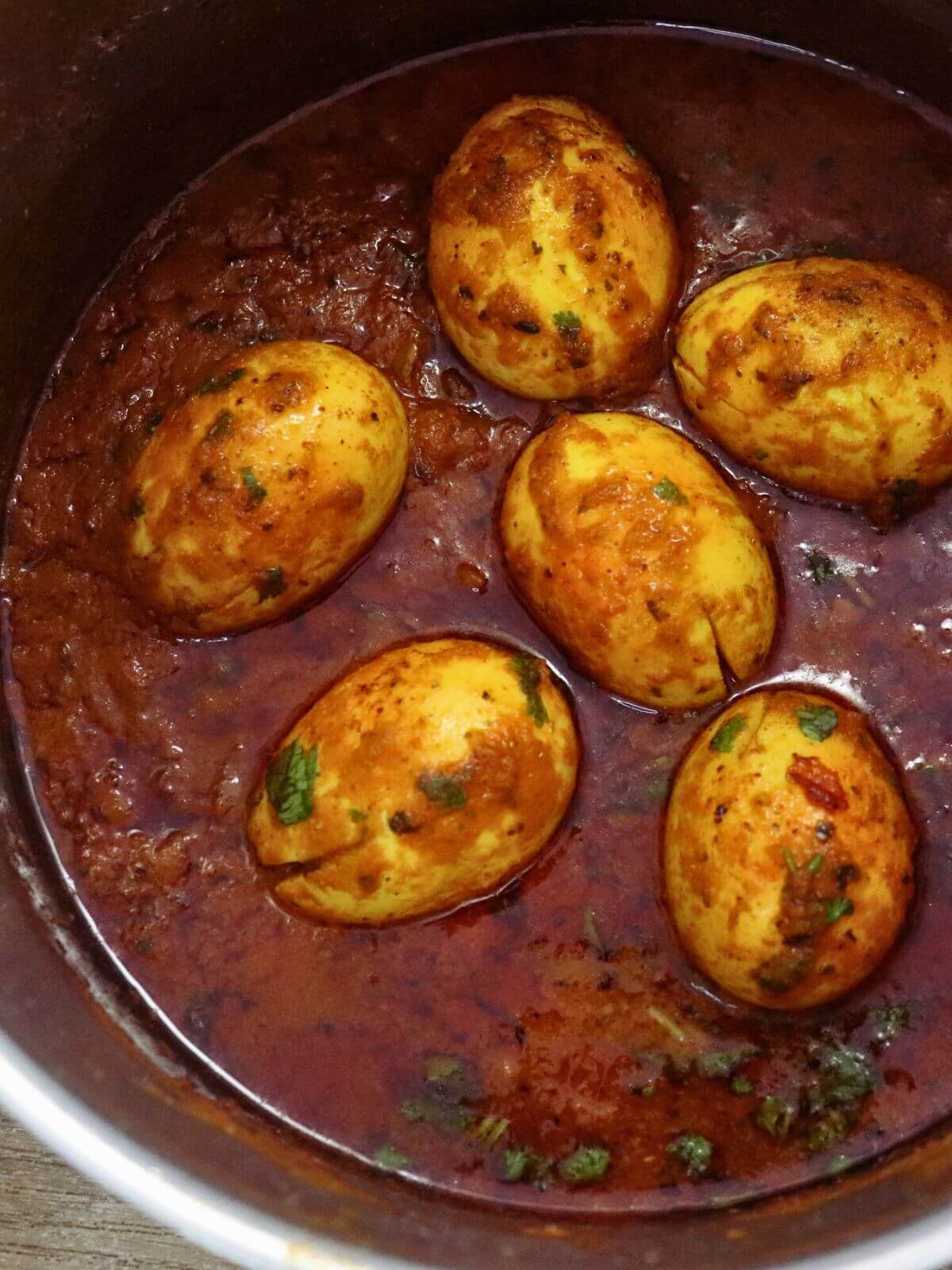
Jump to:
This simple egg masala recipe gives you a flavorful egg curry, made with everyday ingredients, like onions, tomatoes, and warm spices. Whether with rice or roti, this anda curry recipe is my go-to for a quick and comforting meal that my family loves.
Growing up in North India, I had this anda curry almost every week, sometimes twice because we loved it so much. This egg curry masala is so flavorful that I always end up eating extra rotis. If you love simple North Indian meals, try it with jeera rice or garlic naan. More comforting North Indian curry recipes that you may like are our chicken masala, bhuna chicken, or paneer masala. These are our family favorites and we are happy to share them with you.
About This Egg Masala (Anda Curry)
This egg masala recipe, I am sharing here is a North Indian, home-style egg curry recipe, made with simple ingredients. It is popularly known as 'anda curry' in the north, and 'anda' means eggs.
In North India, egg curry varies from region to region, with no single authentic recipe. However, the basic ingredients like onion, tomato, ginger, garlic, and spices remain the same. This anda curry recipe is our simple, home-style version, the way we make it at home.
This North Indian-style anda masala is packed with delicious flavors. The masala for the egg curry is roasted on high heat until the oil separates, creating a unique restaurant-style flavor. Serve it with roti, naan, or rice for a satisfying meal.
You may also like these other popular egg recipes from this website:
Ingredients Notes
This egg curry is a versatile dish with many variations. In North India, egg curry is typically made with an onion-tomato base, which is how I prefer to make anda curry at home. Some add cashews for a creamier texture like this egg curry, while in the South, coconut is often used. Here’s what you will need to make this egg masala.
- Boiled eggs: I always use hard-boiled eggs for my egg curry recipes. In this post, I shared the recipe to cook perfect hard-boiled eggs.
- Onion, ginger, garlic, and green chilies: These are the basics of most Indian curries. I used red onions for this spicy anda curry. Green chilies are optional. If you do not prefer spicy egg curry then skip them.
- Tomatoes: I added fresh tomatoes to make the masala for egg curry. Blend fresh tomatoes and make a paste. You can substitute it with passata or canned tomatoes.
- Spice Powders: I used basic North Indian spices that we use in everyday cooking like turmeric powder, coriander powder, red chili powder, and garam masala powder. I added Kashmiri red chili powder for a bright red color and it’s not too spicy. If you don't have Kashmiri red chili powder, regular red chili powder or paprika will work just fine. Adjust the quantity to your preference.
- Cumin: Whole cumin seeds add a very nice flavor when added to the tempering.
- Oil: You can use any neutral oil with a high smoke point for this anda masala. I have used sunflower oil for this anda masala curry recipe.
For the detailed list of ingredients & their measurements, please check out the recipe card below.
How To Make Egg Masala Curry (With Step By Step Photos)
Preparations for Anda Curry
1) Boil the eggs: Put the eggs in a saucepan and cover them with water (ensure the eggs are completely submerged.). Turn the heat up high until the water comes to a rolling boil. Then, turn off the heat, cover with a lid, and let the eggs sit in the hot water for 12 minutes. Drain the eggs and put them in a bowl of ice water to cool down. Leave them there for at least 15 minutes before peeling them. Take out the eggs and peel them one by one. Hard-boiled eggs are ready. Make small incisions in the eggs.
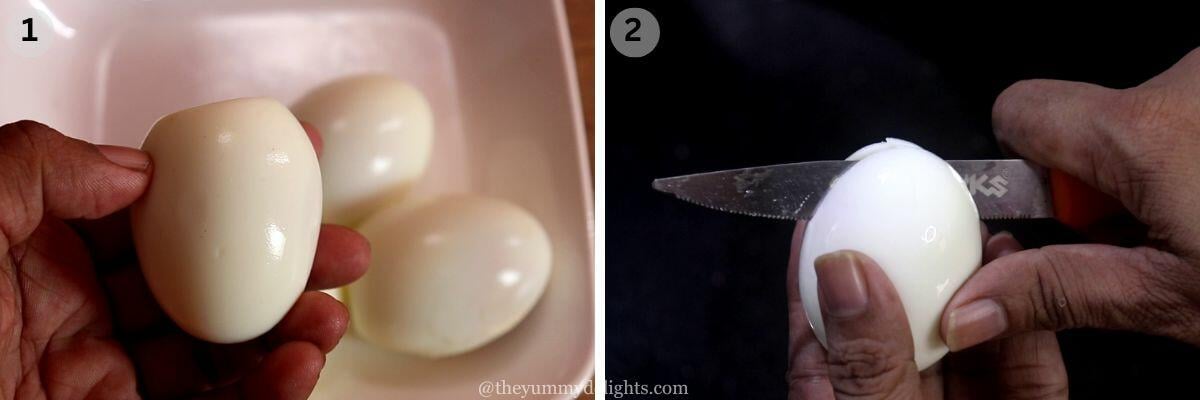
2) Preparing a ginger-garlic-chili paste: Blend ginger, garlic, and green chilies to a smooth paste. You can do it in a blender jar or mortar and pestle.
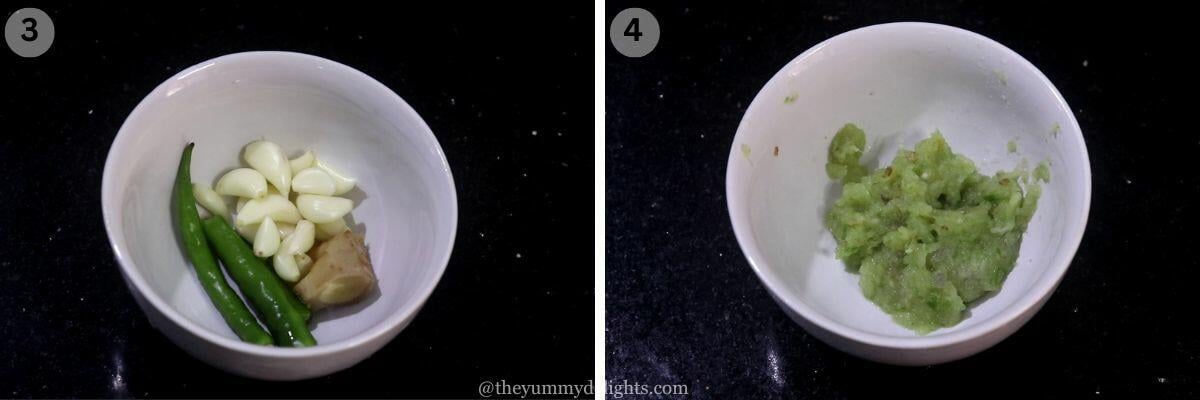
Making the Egg Masala Curry
1) Add cumin seeds and onion: Heat oil in a deep-bottomed pan or kadai over medium heat. Add cumin seeds and allow them to crackle. Add chopped onion.
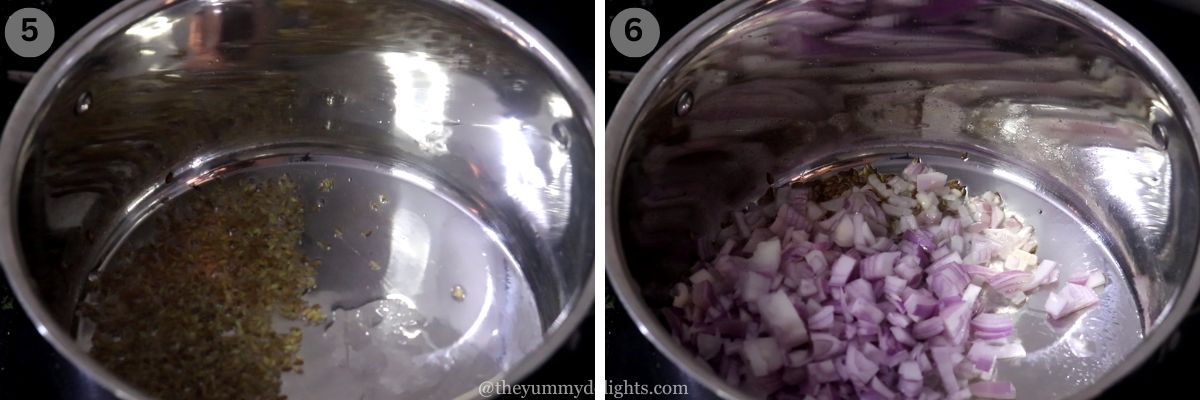
2) Saute aromatics: Sauté onions until they are light golden brown. Stir in the prepared ginger-garlic green chili paste and sauté for about a minute.
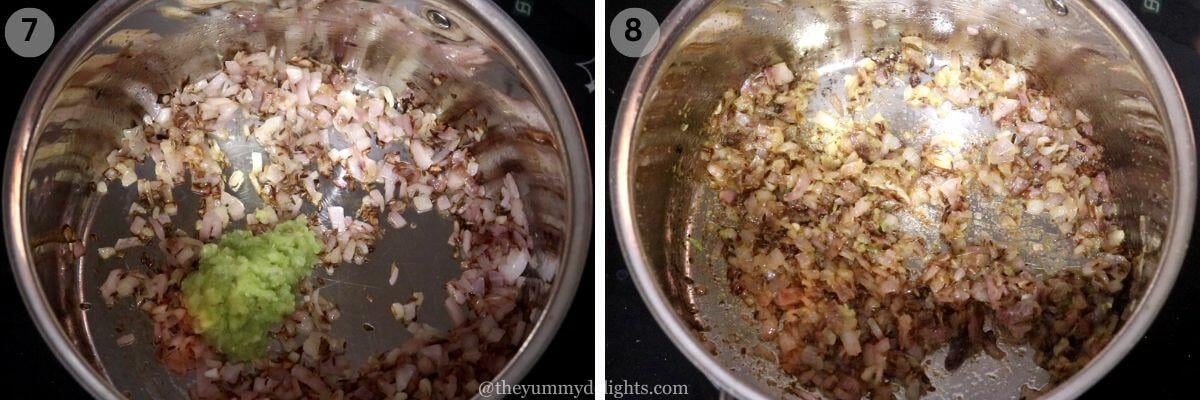
3) Add spice powders: Reduce the heat, add spice powders, and sauté for another minute.
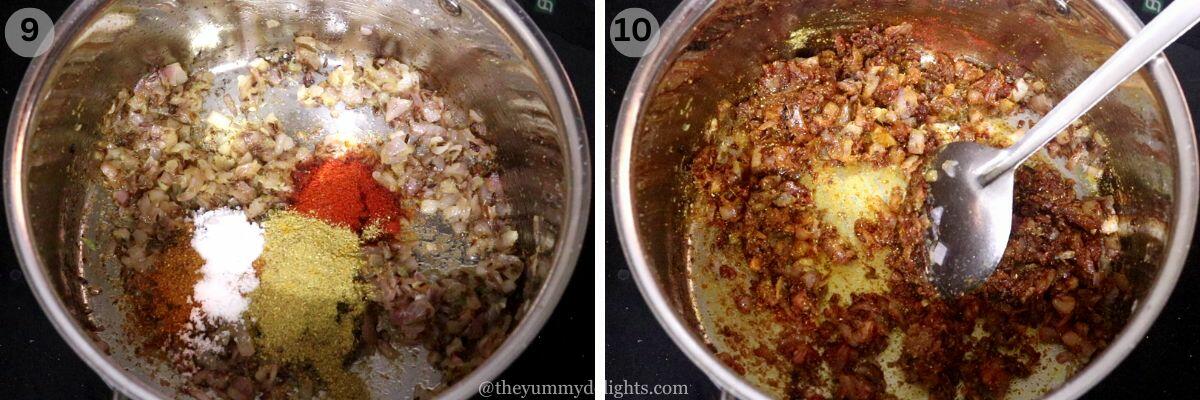
4) Cooking the masala: The spice powder sticks to the bottom of the pot. At this stage add a small amount of water and cook stirring continuously until all the water is absorbed. Keep the heat on medium. Again add a little water and cook until the masala oil floats to the surface and separates from the sides of the pan.
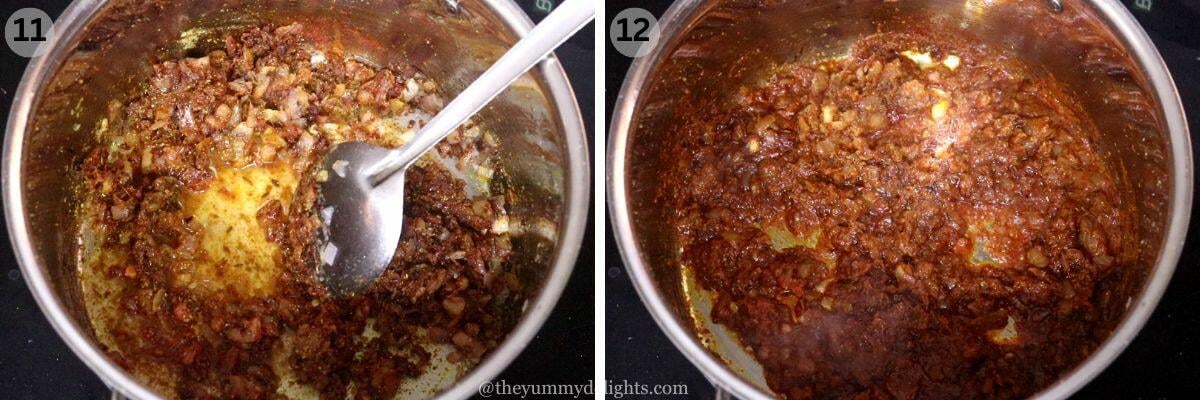
5) Add tomato paste and cook: Stir in tomato paste and bring to a boil. Add water to adjust the consistency of this egg curry. Do not make the curry too thin as it will dilute the flavors. Cover and simmer for 15 minutes, allowing the flavors to meld. Stir it in between as required.
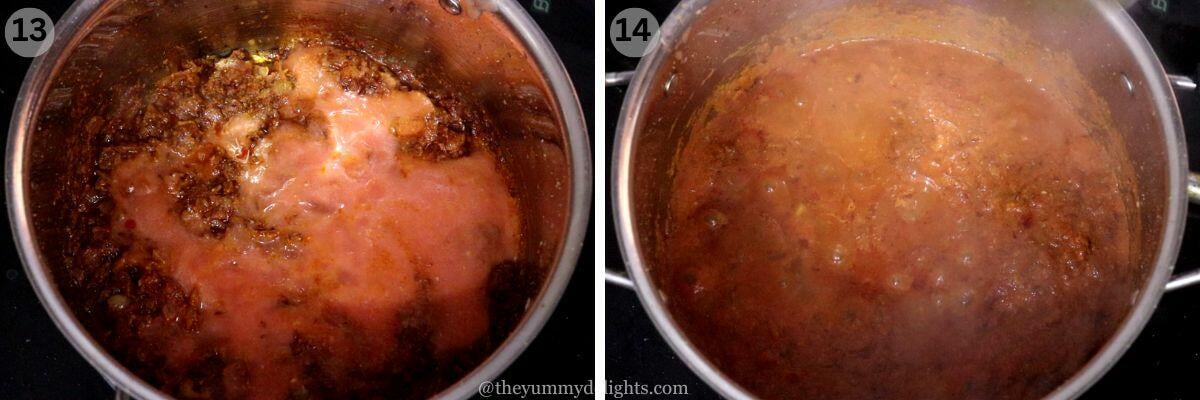
6) Stir-fry the boiled eggs: Meanwhile, heat oil in a separate pan over low heat. Add turmeric and red chili powder. Add the boiled eggs and stir-fry until they are lightly golden. Do not overcook them.
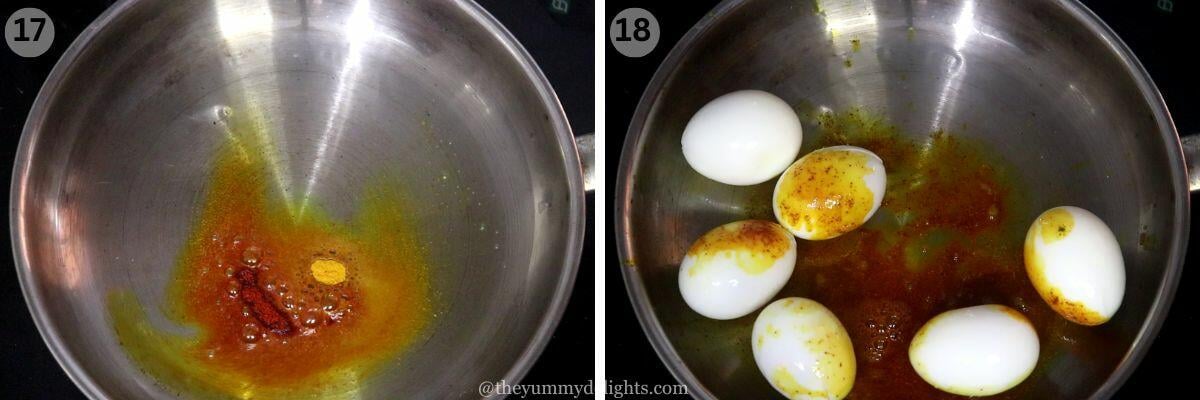
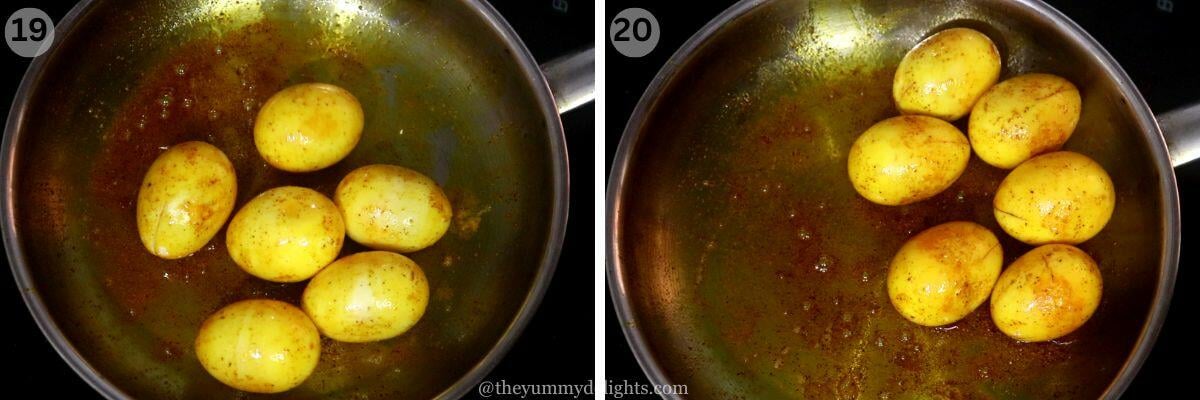
7) Add kasuri methi to the curry and mix. It will add that authentic egg masala flavor that we get in dhaba.
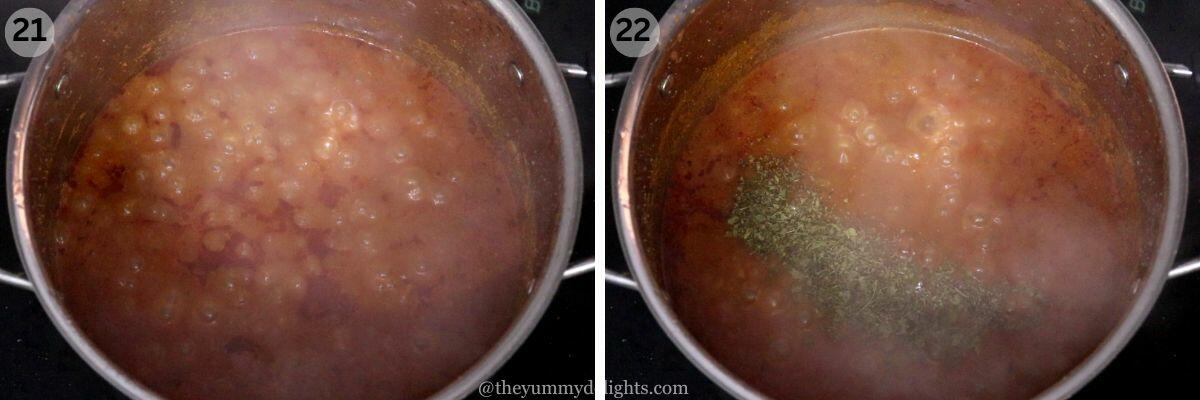
8) Add eggs and cook: Add the stir-fried eggs to the curry. Cook it for a minute. Egg masala is ready to serve. Remove from heat. Garnish with coriander leaves. Serve anda curry with rice, roti, or naan.
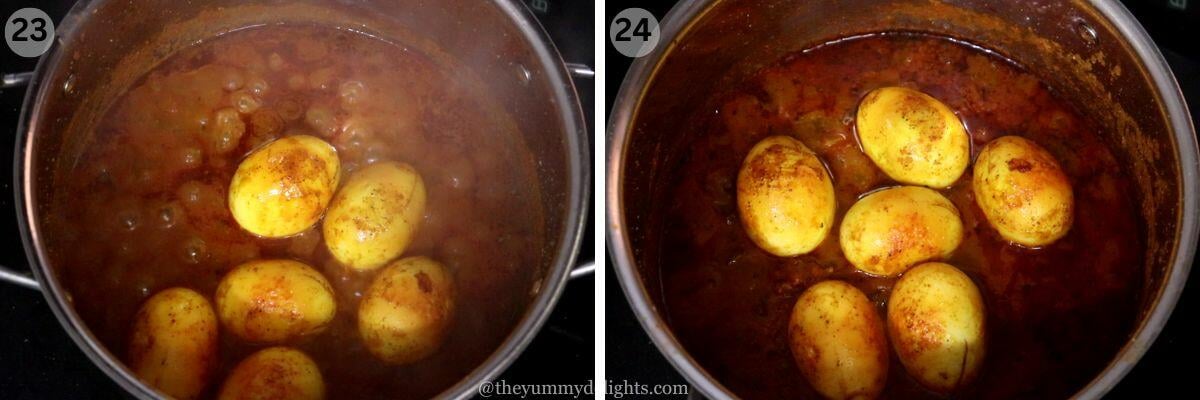
Tips To Make The Best Anda Curry
- Make incisions on the boiled eggs before adding them to the curry. This will allow the egg to soak up the flavors of the onion-tomato masala.
- Stir-frying the boiled eggs with spices before adding them to the curry enhances its flavor and makes the eggs visually appealing.
- When stir-frying the eggs with the masala, use low heat. This allows the spices to be evenly coated by the eggs without burning. High heat can cause the masala to burn quickly in the curry.
- Stir-fry the eggs until they are lightly golden. Overcooking the eggs can cause the outer skin to become tough or rubbery.
- Be patient while cooking the spice powders in the masala. Cook until the oil rises to the surface. This is important, as the flavors develop, and it ensures that the masala is well-cooked when the oil separates from it.
Frequently Asked Questions
Yes, you can use frozen eggs for making this egg masala. Make sure to thaw them completely before using them in egg curry.
Yes, you can add other vegetables like spinach, potatoes, peas, or bell peppers to your egg curry for a more filling and flavorful dish.
Egg masala is spicier than egg curry. Egg curry has a mild flavor with a hint of sweetness from either coconut milk or cream.
You can serve this anda masala with jeera rice, pulao, roti, or Naan.
Anda Curry Variations
- For creamier egg masala, add cashews while blending tomatoes. This will add a creamier texture to the curry. Soak the cashews in water for 30 minutes before grinding for a smooth texture of the curry.
- You can also add coconut milk towards the end. It will add a slightly sweet flavor and creamy texture to the curry.
- Add vegetables. Stir in chopped spinach, potatoes, or green peas for a heartier dish.
- Make it vegetarian and add Paneer or Tofu.
If you try this recipe, please leave a comment and rating below. We'd love to hear your feedback.
And, consider following me on social media so we can stay connected. I’m on Facebook, Pinterest, and YouTube!
Related Recipes
Recipe Card
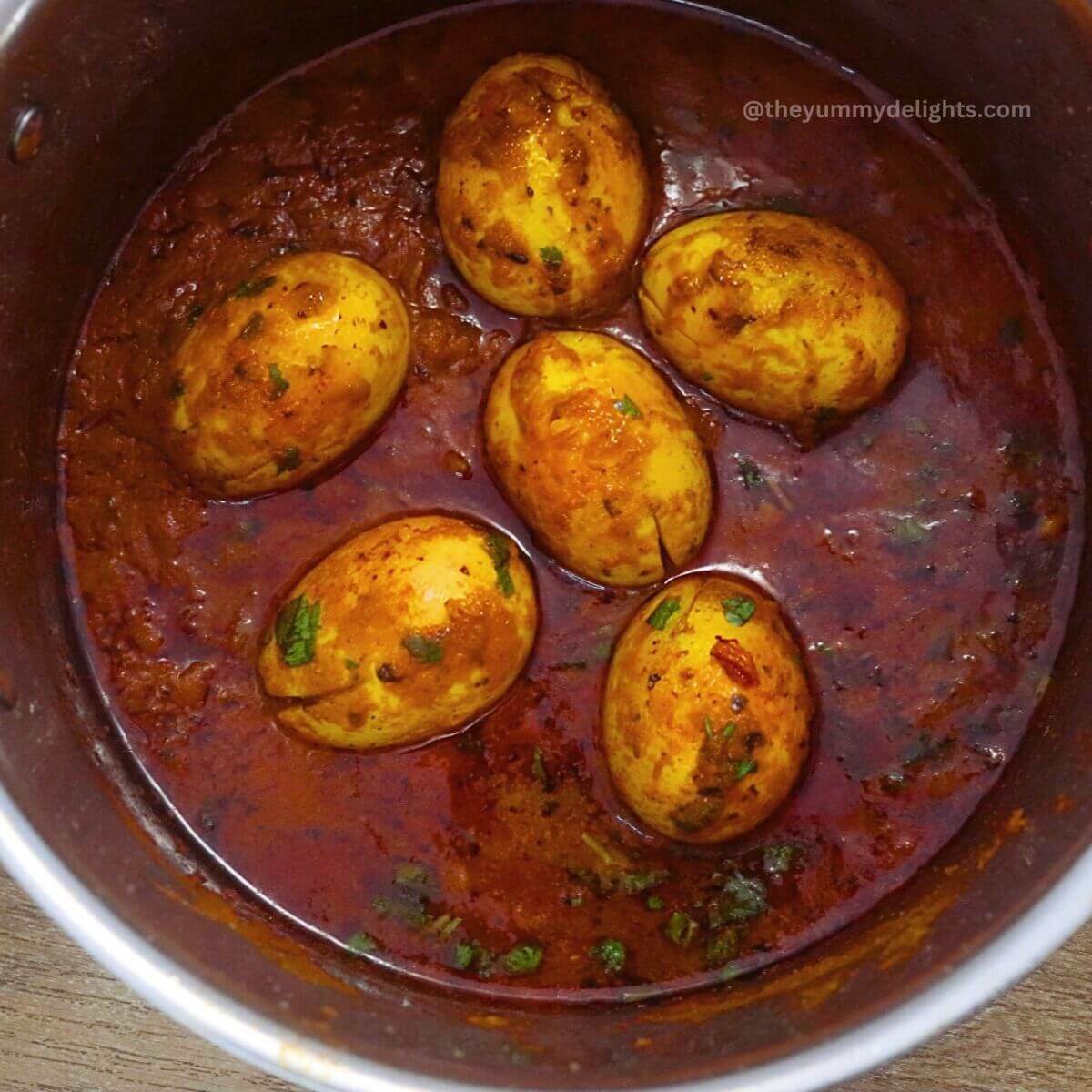
Egg Masala Recipe (Anda Curry)
Equipment
- 1 Heavy bottom pot with lid
- 1 Skillet
Ingredients
For Egg Masala
- 6 eggs
- 2 green chilies (optional) add as per taste
- 8-10 garlic cloves
- 1- inch ginger
- 1 teaspoon cumin seeds
- 2 onions, finely chopped about ½ cup
- ½ teaspoon turmeric powder
- 2 teaspoon Kashmiri red chili powder
- 2 teaspoon coriander powder
- 1 teaspoon garam masala powder
- 1 teaspoon salt or add per taste
- 1 cup fresh tomato puree (blend fresh tomatoes or use tomato passata)
- 1 teaspoon roasted kasuri methi
- 2 tablespoon oil
- Fresh coriander leaves
To Stir-Fry Eggs
- ¼ teaspoon turmeric
- ½ teaspoon Kashmiri red chili powder
Instructions
- Boil the eggs: Put the eggs in a saucepan and cover them with water (ensure the eggs are completely submerged.). Turn the heat up high until the water comes to a rolling boil. Then, turn off the heat, cover with a lid, and let the eggs sit in the hot water for 12 minutes. Drain the eggs and put them in a bowl of ice water to cool down. Leave them there for at least 15 minutes before peeling them. Take out the eggs and peel them one by one. Hard-boiled eggs are ready. Make small incisions in the eggs.
- Preparing a ginger-garlic-chili paste: Blend ginger, garlic, and green chilies to a smooth paste. You can do it in a blender jar or mortar and pestle.
- Add cumin seeds and onion: Heat 2 tablespoon of oil in a deep-bottomed pan or kadai over medium heat. Add cumin seeds and allow them to crackle.
- Sauté aromatics: Add chopped onion and sauté until they are light golden brown. Stir in the prepared ginger-garlic green chili paste and sauté for about a minute.
- Add spice powders: Reduce the heat, add turmeric powder, Kashmiri red chili powder, coriander powder, garam masala powder and salt. Sauté for another minute.
- Cooking masala: The spice powder sticks to the bottom of the pot. At this stage add a small amount of water (I added 2 tbsp) and cook stirring continuously until all the water is absorbed. Keep the heat on medium. Again add a little water and cook stirring continuously until the masala oil floats to the surface and separates from the sides of the pan. Avoid adding any extra oil at this stage.
- Add tomato paste and cook: Stir in tomato paste and bring to a boil. Add water to adjust the consistency of this egg curry. Do not make the curry too thin as it will dilute the flavors. Cover and simmer for 15 minutes, allowing the flavors to meld. Stir it in between as required.
- Stir-fry the boiled eggs: Meanwhile, heat 2 teaspoon of oil in a separate pan over low heat. Add turmeric and red chili powder. Add the boiled eggs and stir-fry until they are lightly golden. Keep stirring the eggs. Do not overcook them.
- Add kasuri methi to the curry and mix.
- Add eggs and cook: Add the stir-fried eggs to the curry. Cook it for a minute. Remove from heat. Garnish with coriander leaves. Serve egg masala with rice, roti, or naan.
Video

Notes
-
- Make incisions on the boiled eggs before adding them to the curry. This will allow the egg to soak up the flavors of the onion-tomato masala.
- Stir-frying the boiled eggs with spices before adding them to the curry enhances its flavor and makes the eggs visually appealing.
- When stir-frying the eggs with the masala, use low heat. This allows the spices to be evenly coated by the eggs without burning. High heat can cause the masala to burn quickly in the curry.
- Stir-fry the eggs until they are lightly golden. Overcooking the eggs can cause the outer skin to become tough or rubbery.
- Be patient while cooking the spice powders in the masala. Cook until the oil rises to the surface. This is important, as the flavors develop, and it ensures that the masala is well-cooked when the oil separates from it.
- Storage - Leftover egg curry can be stored in an airtight container in the refrigerator. It stays good for 2 days. Reheat and serve. Not a freezer-friendly recipe.
- Read our full nutrition disclaimer here.
Nutrition

Hi! I’m Preeti Nayak, and with over two decades of hands-on experience in Indian cooking, I’m excited to share my passion with you. As the author, photographer, and editor behind every well-tested, family-friendly recipe on this blog, my goal is to help you cook with confidence and bring the bold, authentic flavors of India to your table.


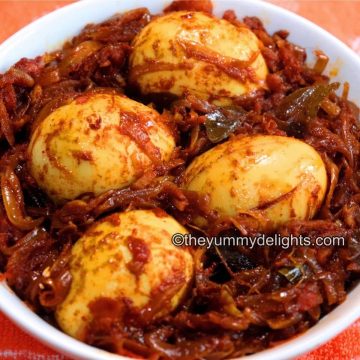
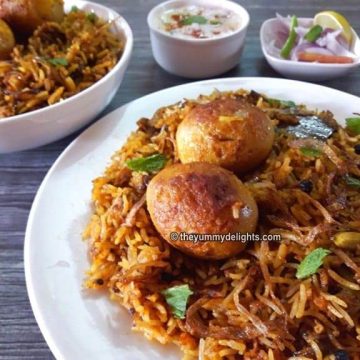
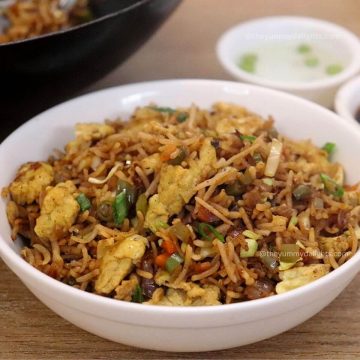
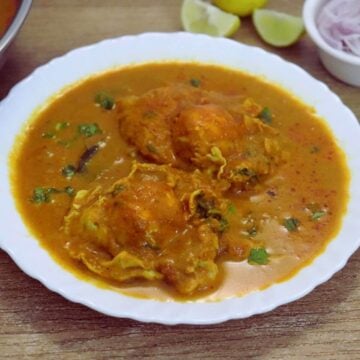



Rick
This Egg Masala recipe looks delicious! I love how you've included detailed steps and tips for perfecting the dish. Can't wait to try this out for dinner tonight!